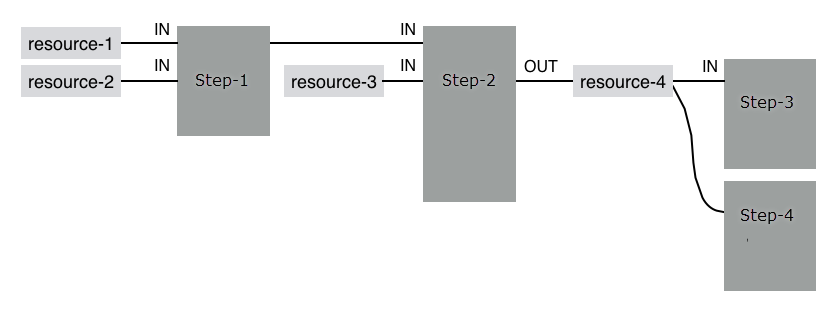Features
Pipelines as Code
Define your automated pipeline workflow through code, using a domain specific language in a YAML file of key-value pairs that you can create and maintain with your favorite text editor.
For information on creating pipeline workflows in YAML, see theJFrog Pipelines Developers Guide.
Graphical Display
JFrog Pipelines renders your pipeline definition as an interactive diagram, helping you to看到的任务和他们的相互依赖关系, as well as view the success record of any runs that were performed.
Integrates with Third-Party Tools
Connect your pipeline automation to your source code repositories in a version control system (such as GitHub or BitBucket) to automatically trigger execution on any new submission (commit) of a code change. Connect to other popular tools through your credentials for storage, issue-tracking, notification, orchestration and more through a library ofintegrations.
Native Integration with Artifactory and Xray
JFrog Pipelines is designed to be used with Artifactory, with built-in directivesfor pushing artifacts, performing builds, pushing build information, image scanning, and build promotion.
Integration with JFrog Platform
JFrog Pipelines is designed as an integral part of the JFrog platform, including thecreation and delivery of release bundles through JFrog Distribution, for a complete end-to-end SDLC pipeline from commit to production runtime.
Built for Enterprise-Class Scale
Manage multiple execution nodes using a single installation of Pipelines and automatically distribute Pipeline execution across them for scale and speed.
Getting Started
How you will begin using JFrog Pipelines will depend on the role that you play in your organization:
Administrators
Pipelines Administrators allocate and configure the available resources that may be used by Pipelines workflows, and control who may have access to them. In this way, administrators can govern security and overall costs of usage. A Pipelines Administratormust have a JFrog Platform user account with broad permissions.
When JFrog Pipelines is first installed, you'll need to configure it so that your workflows have places to execute and can connect to the facilities they will use. All of these activities are started through theConfigurationbutton.
To get started, a PipelinesAdministratormust install and configure JFrog Pipelines so that users' workflows have places to execute and can connect to the facilities they will use.
Install Pipelines
For self-managed installations (BYOL for on-prem or cloud hosted), Pipelines must first be installed in a single server or high-availability configuration.
If you are using Pipelines through a SaaS subscription, Pipelines is installed for you on the hosting cloud service and is immediately available for an administrator to configure.
Create Execution Node Pools
Administrators must create at least one node pool for an architecture/OS and populate it with nodes (virtual machines) where the steps of users' Pipelines workflows can execute.
Add Integrations
Administrators must addthe integrations that users will need to access facilities that are external to Pipelines, such as users' GitHub accounts, and Artifactory.
Add Pipeline Sources
Administrators are responsible for adding pipeline sources (such as a Github repo) where a user stores their YAML-based pipeline config files. An administrator also sets user permissions for each pipeline source, to control which users can see the run status and history of the workflows stored in those sources.
Developers
Once your account, integrations, and pipeline sources have been set up by a Pipelines Administrator, you can begin using JFrog Pipelines.
Create Pipelines Workflows
You will create your YAML-based pipeline workflow files and store them in a source control repository, such as on Github. When that repository has been added by an administrator as a pipeline source, it will automatically be loaded into Pipelines and run according to the event triggers specified in the workflow file.
我们来学习如何创建管道流程文件ing the declarative YAML-based language, see theJFrog Pipelines Developers Guide.
View and Trigger Pipelines Runs
Through the JFrog Platform, you can see all of the pipeline worfklows from pipeline sources that you have been granted permissions to view. You can view their run state and history, as well as manually trigger execution from any step in the pipeline workflow.



